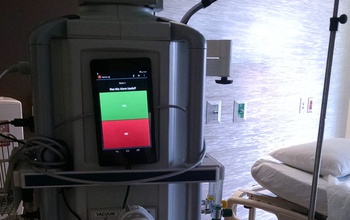News Release 15-096
A partnership to secure and protect the emerging Internet of Things
National Science Foundation and Intel Corporation team to improve the security and privacy of computing systems that interact with the physical world using a new cooperative research model

Researchers will adapt smart alarm research to detect and react to attacks on medical devices.
August 28, 2015
This material is available primarily for archival purposes. Telephone numbers or other contact information may be out of date; please see current contact information at media contacts.
The digital world once existed largely in non-material form. But with the rise of connected homes, smart grids and autonomous vehicles, the cyber and the physical are merging in new and exciting ways. These hybrid forms are often called cyber-physical systems (CPS), and are giving rise to a new Internet of Things.
Such systems have unique characteristics and vulnerabilities that must be studied and addressed to make sure they are reliable and secure, and that they maintain individuals' privacy.
The National Science Foundation (NSF), in partnership with Intel Corporation, one of the world's leading technology companies, today announced two new grants totaling $6 million to research teams that will study solutions to address the security and privacy of cyber-physical systems. A key emphasis of these grants is to refine an understanding of the broader socioeconomic factors that influence CPS security and privacy.
"Advances in the integration of information and communications technologies are transforming the way people interact with engineered systems," said Jim Kurose, head of Computer and Information Science and Engineering at NSF. "Rigorous interdisciplinary research, such as the projects announced today in partnership with Intel, can help to better understand and mitigate threats to our critical cyber-physical systems and secure the nation's economy, public safety, and overall well-being."
The partnership between NSF and Intel establishes a new model of cooperation between government, industry and academia to increase the relevance and impact of long-range research. Key features of this model for projects funded by NSF and Intel include joint design of a solicitation, joint selection of projects, an open collaborative intellectual property agreement, and a management plan to facilitate effective information exchange between faculty, students and industrial researchers.
This model will help top researchers in the nation's academic and industrial laboratories transition important discoveries into innovative products and services more easily.
"The new CPS projects, announced today, enable researchers to collaborate actively with Intel, resulting in strong partnerships for implementing and adopting technology solutions to ensure the security and privacy of cyber-physical systems," said J. Christopher Ramming, director of the Intel Labs University Collaborations Office. "We are enthusiastic about this new model of partnership."
The NSF-Intel partnership further combines NSF's experience in developing and managing successful large, diverse research portfolios with Intel's long history of building research communities in emerging technology areas through programs such as its Science and Technology Centers Program.
The projects announced today as part of the NSF/Intel Partnership on Cyber-Physical Systems Security and Privacy are:
- Insup Lee, University of Pennsylvania: Security and Privacy-Aware Cyber-Physical Systems
- Philip Levis, Stanford University: CPS-Security: End-to-End Security for the Internet of Things
Rapidly increasing incorporation of networked computation into everything from our homes to hospitals to transportation systems can dramatically increase the adverse consequences of poor cybersecurity, according to Philip Levis, who leads a team at Stanford University that received one of the new awards. Levis' team investigates encryption frameworks for testing and protecting networked infrastructure.
"Our research aims to lay the groundwork and basic principles to secure computing applications that interact with the physical world as they are being built and before they are used," Levis said. "The Internet of Things is still very new. By researching these principles now, we hope to help avoid many security disasters in the future."
The team, consisting of researchers from Stanford University, the University of California, Berkeley, and the University of Michigan, considers how new communication architectures and programming frameworks can help developers avoid decisions that lead to vulnerabilities.
Another project explores the unique characteristics of cyber-physical systems, such as the physical dynamics, to provide approaches that mix prevention, detection and recovery, while assuring certain levels of guarantees for safety-critical automotive and medical systems.
"With this award, we will develop robust, new technologies and approaches that work together to lead to safer, more secure and privacy-preserving cyber-physical systems by developing methods to tolerate attacks on physical environment and cyberspace in addition to preventing them," said Insup Lee, who leads a team at the University of Pennsylvania, along with colleagues at Duke University and the University of Michigan.
"New smart cyber-physical systems technologies are driving innovation in sectors such as food and agriculture, energy, transportation, building design and automation, healthcare, and advanced manufacturing," Kurose said. "With proper protections in place, CPS can bring tremendous benefits to our society."
The new program extends NSF's investments in fundamental research on cyber-physical systems, which has totaled more than $200 million in the past five years.
NSF is also separately investing in three additional CPS security and privacy projects that address the safety of autonomous vehicles, the privacy of data delivered by home sensors and the trustworthiness of smart systems:
- David Irwin, University of Massachusetts Amherst: Enhancing Privacy in Smart Buildings and Homes
- Jonathan Kimball, Missouri University of Science and Technology: Secure Algorithms for Cyber-Physical Systems
- Minghui Zhu, Pennsylvania State University: Towards Provably Correct Distributed Attack-Resilient Control of Unmanned-Vehicle-Operator Networks
-NSF-
-
NSF teams with Intel Corporation to enhance the security, privacy of cyber-physical systems.
Credit and Larger Version -
CPS integrates sensing, computation, control and networking into physical objects and infrastructure
Credit and Larger Version
Media Contacts
Aaron Dubrow, National Science Foundation, (703) 292-4489, email: adubrow@nsf.gov
Tom Abate, Stanford University, (650) 736-2245, email: tabate@stanford.edu
Joan Gocke, University of Pennsylvania, (215) 898-8103, email: gocke@seas.upenn.edu
Robert Manetta, Intel Corporation, (408) 653-3683, email: robert.i.manetta@intel.com
Principal Investigators
Philip Levis, Stanford University, (650) 725-9046, email: pal@cs.stanford.edu
Insup Lee, University of Pennsylvania, (215) 898-3532, email: lee@cis.upenn.edu
Jesse Walker, Intel Corporation, (503) 712-1849, email: Jesse.walker@intel.com
The U.S. National Science Foundation propels the nation forward by advancing fundamental research in all fields of science and engineering. NSF supports research and people by providing facilities, instruments and funding to support their ingenuity and sustain the U.S. as a global leader in research and innovation. With a fiscal year 2023 budget of $9.5 billion, NSF funds reach all 50 states through grants to nearly 2,000 colleges, universities and institutions. Each year, NSF receives more than 40,000 competitive proposals and makes about 11,000 new awards. Those awards include support for cooperative research with industry, Arctic and Antarctic research and operations, and U.S. participation in international scientific efforts.
Connect with us online
NSF website: nsf.gov
NSF News: nsf.gov/news
For News Media: nsf.gov/news/newsroom
Statistics: nsf.gov/statistics/
Awards database: nsf.gov/awardsearch/
Follow us on social
Twitter: twitter.com/NSF
Facebook: facebook.com/US.NSF
Instagram: instagram.com/nsfgov




